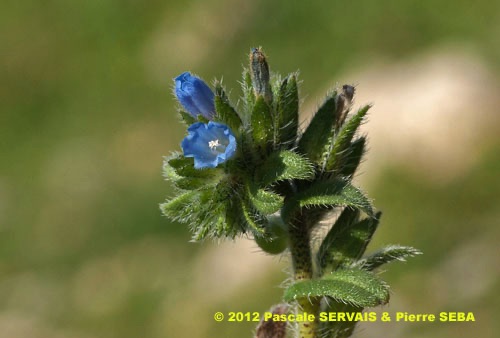
Echium italicum subsp. italicum
Fam. : Boraginaceae
© Pascale SERVAIS & Pierre SEBA, 2018. Tilo Botanica: Flore de Tilos et du Dodécanèse / Flora of Tilos and of the Dodecanese
English translation by Brenda Bradbury, Howard Bradbury and Stéphane Léonard
Plante herbacée, hermaphrodite, à nombreuses tiges dressées, à poils rudes.
Feuilles alternes, simples, de 2 à 8 cm de long, couvertes de poils rudes, les inférieures spatulées à oblongues, à pétiole long, les supérieures oblongues à ovales et sessiles. Une seule nervure nettement apparente.
Fleurs à symétrie bilatérale, presque régulières, bleu pâle à foncé, de 8 à 13 mm de long, réunies en grappes de 4 à 12 cm. Corolle tubuleuse, campanulée, poilue, à 5 dents arrondies disposées obliquement. Calice à 5 sépales velus, de 6 à 8 mm de long. 5 étamines non saillantes. Ovaire supère.
Fruits, 4 akènes noirs à maturité, couverts de fins tubercules.
___________________________
Plant herbaceous, hermaphrodite. Stems numerous, erect, with hard hairs.
Leaves alternate, simple, from 2 to 8 cm long, covered in hard hairs, the inferior ones spatulate to oblong, with a long petiole, the superior ones oblong to ovate and sessile. Only one definitely conspicuous vein.
Flowers bilaterally symmetrical, almost regular, pale blue to dark blue, from 8 to 13 mm long, joined together in racemes from 4 to 12 cm. Corolla tubulous, bell-shaped, hairy, with 5 rounded teeth laid out obliquely. Calyx with 5 very hairy sepals, from 6 to 8 mm long. 5 nonprotruding stamens. Ovary superior.
Fruits, 4 achenes black at maturity, covered in thin tubercles.
Descripteurs / Identifying features
1
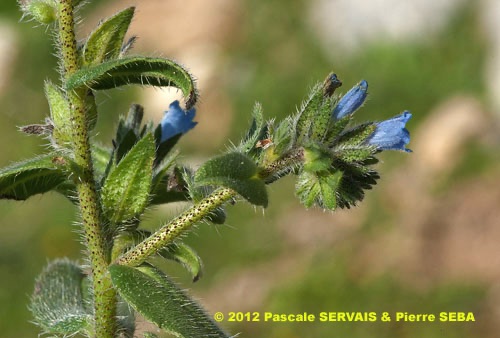
2
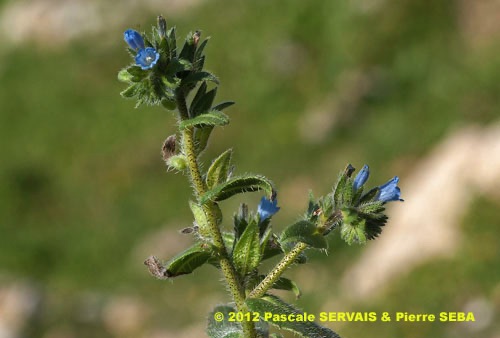
3
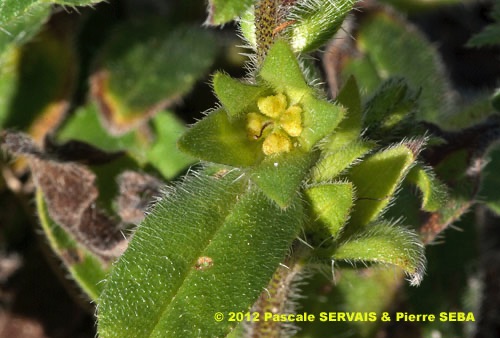
4
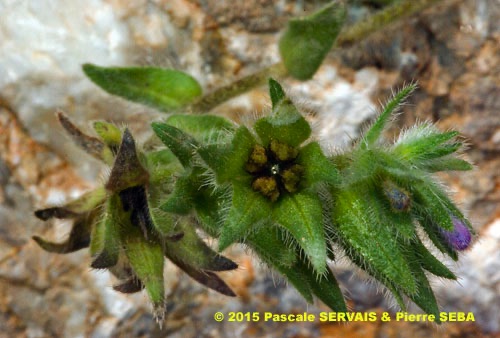
5
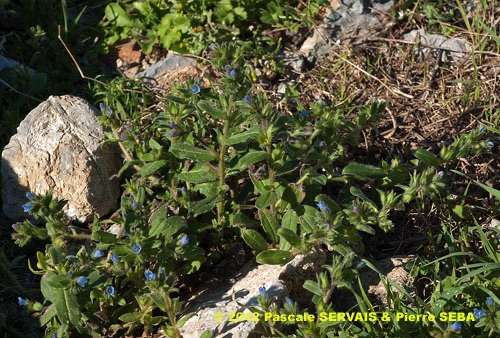
6
Étymologie / Etymology :
Echium : emprunt du grec ancien ἔχιον, -ου (nom) [ < ἔχις, -εως (nom)
= la vipère ] = la vipérine, nom donné à la plante par Dioscoride,
médecin et botaniste grec mort en 90 apr. J.-C., en référence aux
fruits qui ressemblent à la tête d’une vipère qui tire la langue.
Italicum : emprunt du latin italicus, -a, -um (adj.)
[ < Italia, -ae (nom propre) = l’Italie ] = italien, d’Italie, qui vient d’Italie.
Echium : borrowed from Classical Greek ἔχιον, -ου (noun)
[ < ἔχις, -εως (noun) = viper ] = viper’s bugloss, name given to the
plant by Dioscorides, Greek doctor and botanist died in 90 AD,
referring to the fruits resembling the head of a viper sticking out
its tongue.
Italicum : borrowed from Latin italicus, -a, -um (adj)
[ < Italia, -ae (proper noun) = Italy ] = Italian, of or from Italy, which
comes from Italy.
Synonymes / Synonyms :
Echium parviflorum Moench
Echium albereanum Naudin & Debeaux
Echium altissimum Jacq.
Echium asperrimum subsp. luteum sensu Jovet & R.Vilm.
Echium collinum Salisb.
Echium italicum subsp. albereanum (Naudin & Debeaux) Greuter & Burdet
Echium italicum subsp. altissimum (Jacq.) Nyman
Echium italicum subsp. luteum auct.
Echium ramosum Gaterau
Isoplesion italicum (L.) Raf.
Noms vernaculaires / Common names :
Noms français / French names :
Échium d’Italie — Vipérine d’Italie.
Noms grecs / Greek names :
Γαϊδουρόγλωσσα — Έχιο το ιταλικό — Έχιον ιταλικό —
Κορθόγκλι — Μανούνι — Τουλπάνι.
Noms anglais / English names :
Italian viper’s bugloss — Italian vipersbugloss — Pale bugloss —
Small flowered bugloss.
Noms allemands / German names :
Hoher Natternkopf — Italienischer Natterkopf —
Kleinblütiger Natternkopf.
Nom espagnol / Spanish name :
Bolenga.
Noms italiens / Italian names :
Viperina a fiori piccoli — Viperina maggiore —
Viperina maggiore italiana.
Habitat :
Cultures - Lieux pierreux - Lieux incultes - Sols sableux - Chemins.
Cultivated places - Stony places - Waste ground - Sandy soils -
Waysides.
Île / Island :
Tilos.
Hauteur / Height range :
De 10 cm à 50 cm.
From 10 cm to 50 cm.
Floraison / Flowering time :
De janvier à juin.
From January to June.
Groupe / Classification :
Dicotylédones.
Dicotyledons.
Pérennité / Lifespan :
Annuelle ou bisannuelle.
Annual or biennial.
Description :
Clés dichotomiques et descripteurs distinctifs des 4 espèces / Dichotomous keys and distinctive identifying features of the 4 species
Photo 1 :
Localisation / Location : Tilos, Megalochorio, Aghios Andonis
Date : 17/03/2012
GPS : Lat. 36,45970° N / Long. 27,33605° E / Alt. 6 m
Type : Photographie numérique / Digital Photograph (10 mégapixels)
Photo 2 :
Localisation / Location : Tilos, Megalochorio, Aghios Andonis
Date : 17/03/2012
GPS : Lat. 36,45970° N / Long. 27,33605° E / Alt. 6 m
Type : Photographie numérique / Digital Photograph (10 mégapixels)
Photo 3 :
Localisation / Location : Tilos, Megalochorio, Aghios Andonis
Date : 17/03/2012
GPS : Lat. 36,45970° N / Long. 27,33605° E / Alt. 6 m
Type : Photographie numérique / Digital Photograph (10 mégapixels)
Photo 4 :
Localisation / Location : Tilos, Megalochorio, Aghios Andonis
Date : 17/03/2012
GPS : Lat. 36,45970° N / Long. 27,33605° E / Alt. 6 m
Type : Photographie numérique / Digital Photograph (10 mégapixels)
Photo 5 :
Localisation / Location : Tilos, Livadia, Chemin de Lethra
Date : 22/04/2008
GPS : Lat. 36,42188° N / Long. 27,38810° E / Alt. 46 m
Type : Photographie numérique / Digital Photograph (10 mégapixels)
Photo 6 :
Localisation / Location : Tilos, Megalochorio, Aghios Andonis
Date : 17/03/2012
GPS : Lat. 36,45970° N / Long. 27,33605° E / Alt. 6 m
Type : Photographie numérique / Digital Photograph (10 mégapixels)

Google Maps
Google Maps
Google Maps
Google Maps
Google Maps
Google Maps